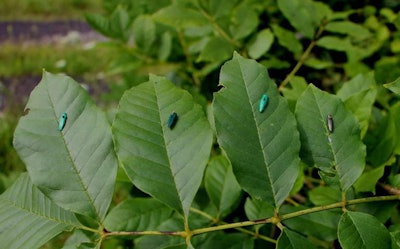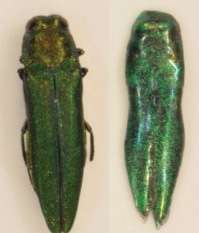 The different decoys were placed on leaves to see which attracted male EABs to land.
The different decoys were placed on leaves to see which attracted male EABs to land.Photo: Michael Domingue/Penn State
The emerald ash borer is a threat to every ash tree it has not already killed, and there hasn’t been much good news on slowing the beetle’s spread across the country since it arrived in Michigan in 2002. One breakthrough, however, could result in earlier detection.
An international team of researchers, including entomologists and engineers from Penn State, the Hungarian Academy of Sciences, the Forest Research Institute in Matrafured, Hungary, and the USDA, has been working for years on creating a female EAB decoy that could successfully attract the males.
The group, which began its work in 2010, originally had been trying to trap male EAB by placing dead females as bait for their traps. This was not ideal so they approached Akhlesh Lakhtakia, the Charles Godfrey Binder professor of engineering science and mechanics at Penn State, about creating a lure similar to the females.
“Specifically, we coated a dead female beetle with a vapor of nickel, and used the ‘nickelized’ shell to fabricate two matching molds in the shape of a resting beetle,” Lakhtakia told Penn State News. “Pressing a structurally colored plastic sheet between the two molds while simultaneously applying heat, we cast numerous replicas or decoys. The finished bioreplicated decoys retained the surface texture of the beetle at the nanoscale.”
The researchers also printed decoys with a 3-D printer, but only focused on the shape and size, omitting the details of the insects.
 Left, a dead female emerald ash borer. Right, a bioreplicated decoy.
Left, a dead female emerald ash borer. Right, a bioreplicated decoy.Photo: Left, Michael Domingue; right, Drew Pulsifer/Penn State
The decoys were put to the test in a forest in Hungary where dead EAB females were placed on leaves along with the painted, bioreplicated decoys and the 3-D printed ones.
It was found that the males initially flew toward all three types but were far more likely to land on either the dead females or the bioreplicas. The reason why the bioreplicas were more successful was because of light-scattering properties of the iridescent green shell.
“We learned that not only do color and shape of a resting female beetle play a role in attracting males to a mate, but also the fine-scale texture of the visible surface is important,” said Michael Domingue, a postdoctoral fellow in entomology at Penn State. “Small bumps and spines on the outer surface of their wings and heads that aren’t visible to the human eye scatter light in a distinctive pattern. Beetles appear to be able to recognize this feature of the decoys and are strongly attracted to it.”
Male EABs would quickly leave the bioreplicas once they landed but this was enough time for the charged decoys to kill or stun males with a 4,000-volt shock, causing them to fall into the trap below. The stunned males are contained by a kill strip placed inside the trap.
These femme fatales can serve as an early detection tool, which is important because early treatment of ash trees can extend their lives and may even save them.
“Our laboratory has ongoing research with the USDA Animal Plant Health Inspection Service into remote-reporting, Internet-based technologies, and we will be working to couple this research with our ash-borer detection technique so that activity of the pest can be reported and assessed immediately by APHIS personnel, rather than waiting days or weeks until a trap might usually be checked,” said Thomas C. Baker, professor of entomology at Penn State.
The team also plans to investigate creating decoys to attract other insect species that threaten different trees.










